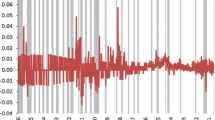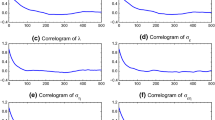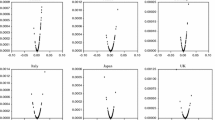Abstract
The current study takes place in a univariate context and we seek to determine an econometric model leading to best characterize the U.S. inflation rate dynamic. In order to achieve this, three types of specifications, associated with three possible evolutions of the expected rate are considered. The first allows an overall instability of the trend or the expected inflation rate. The second considers an alternative specification in which the expected inflation rate is unstable in periodic segments of the sample. Finally, the last specification allows instability of a “mixed” type in which the trend inflation rate is assumed to be random or subject to a probability schema. The results of our study indicate that this last specification is the one that gives the most adequate characterization of the inflation rate dynamic. The inflation rate thus appears generated by a second order autoregressive process with, on the one hand, unchanging lag coefficients and, on the other, a unconditional mean which switches between three globals different frequency regimes of accession.
Similar content being viewed by others
References
Ascari G. (2004) Staggered prices and trend inflation: Some nuisances. Review of Economic Dynamics 7: 642–667
Bai J., Perron P. (1998) Estimating and testing linear models with multiple structural changes. Econometrica 66: 47–78
Bai, J., & Perron, P. (1998). Computation and analysis of multiple structural-change models. Cahier de recherche No. 9807, Université de Montréal.
Bakhshi H., Burriel P., Khan H., Rudolf B. (2007) The new Keynesian Phillips curve under positive trend inflation and strategic complementarity. Journal of Macroeconomics 29: 7–59
Ball, L., Mankiw, N. G. & Romer, D. (1988). The new Keynesian economics and the output-infation trade. Brookings Papers on Economic Activity.
Bils M., Klenow P. (2004) Some evidence on the importance of sticky prices. Journal of Political Economy 112: 947–985
Calvo G. (1983) Staggered prices in a utility-maximizing framework. Journal of Monetary Economics 12: 383–398
Cogley, T., & Sbordone, A. (2005). A search for a structural Phillips curve. Manuscript, Federal Reserve Bank of New York.
Cogley, T., & Sbordone, A. (2006). Trend inflation and inflation persistence in the new Keynesian Phillips curve. Federal Reserve Bank of New York Staff Report No. 270.
Devereux M., Yetman J. (2002) Menu costs and the long-run output. Inflation trade-off. Economics Letters 76(1): 95–100
Friedman, M. (1968). The role of monetary policy. American Economic Review, 58(4), 1–17.
Fuhrer, J. & Moore, G. (1995) Inflation persistence. The Quarterly Journal of Economics.
Gali C., Gertler M. (1999) Inflation dynamics: A structural econometric analysis. Journal of Monetary Economics 44: 195–222
Garcia R. (1998) Asymptotic null distribution of the likelihood ratio test in Markov Swirching models. International Economic Review 39(3): 763–788
Guay, A., & Pelgrin, F. (2004). The U.S. New Keynesian Phillips curve: An empirical assessment. Bank of Canada.
Guay, A., & Pelgrin, F. (2007). Using implied probabilities to improve estimation with unconditional moment restrictions. Cahier de recherche/Working Paper 07-47.
Hamilton, J. (1989). A new approach to the economic analysis of nonstationaty time series and the business cycle. Econometrica, 57, 357–384.
Hamilton, J. (1994). Time series analysis. Princeton University Press.
Hamilton J. (1996) Specification testing in Markov Switching time-series models. Journal of Econometrics 70: 127–157
Hamilton, J. (2001) A parametric approach to flexible nonlinear inference. Econometrica, May 2001, vol. 69.
Hansen B.E. (1992) Testing for parameter instability in linear models. Journal of Policy Modeling 14(4): 517–533
Kang, K.-H., Kim, C.-J., & Morley, J. (2007). Changes in U.S. inflation persistence. Unpublished.
Lucas R. (1972) Econometric testing of the natural rate hypothesis. In: Otto Eckstein (eds) The econometrics of price determination conference reprinted in studies in business cycle theory 1981. MIT Press, Cambridge
Lucas R. (1976) Econometric policy evaluation : A critique. Carnegic-Rochester Series on Public Policy 1: 19–46
Mavroeidis, S. (2007) Testing the new Keynesian Phillips curve without assuming identification, mimeo.
Nyblom J. (1989) Testing for the constancy of parameters over time. Journal of the American Statiscal Association 84(405): 223–230
Phelps E. (1967) Phillips curves, expectations of inflation, and optimal inflation over time. Economica 135: 254–281
Phillips A.W. (1958) The relation between unemployment and the rate of change of money wage rates in the United Kingdom, 1861–1957. Economica 25: 283–299
Reis R., Pivetta F. (2006) The persistence of inflation in the United States. Journal of Economic Dynamics and Control 31(4): 1326–1358
Sahuc, J.-G. (2004). Partial indexation, trend inflation, and the hybrid Phillips curve. Working Paper 04-05, Universite D’Evry.
Samuelson P.A., Solow R. (1960) Analytical aspects of anti-inflation policy. The American Economic Review 50(2): 177–194
Sbordone A. (2002) Prices and unit labor costs: A new test of price stickiness. Journal of Monetary Economics 49(2): 265–292
Solow, R. (1960) Investment and technical Progress, In Arrow, Karlin & Suppes (Eds.), Mathematical Models in Social Sciences.
Solow, R. (1968) Recent controversy on the theory of inflation: An eclectic view. In Stephen W. Rousseas (Ed.), Inflation: Its causes, consequences, and university control. New York.
Author information
Authors and Affiliations
Corresponding author
Rights and permissions
About this article
Cite this article
Boutahar, M., Gbaguidi, D. Which Econometric Specification to Characterize the U.S. Inflation Rate Process?. Comput Econ 34, 145–172 (2009). https://doi.org/10.1007/s10614-009-9168-4
Received:
Accepted:
Published:
Issue Date:
DOI: https://doi.org/10.1007/s10614-009-9168-4




